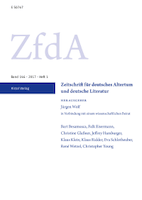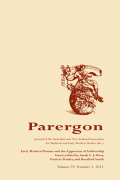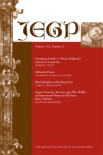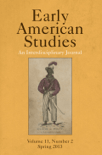
Journal of the Australian Early Medieval Association
Scope & Guideline
Unraveling the Threads of Early Medieval History
Introduction
Aims and Scopes
- Interdisciplinary Historical Analysis:
The journal promotes an interdisciplinary approach to early medieval studies, integrating perspectives from history, archaeology, literature, and cultural studies to provide a comprehensive understanding of the period. - Religious and Cultural Transformations:
A significant focus of the journal is on the transformations in religious beliefs and cultural practices during the early medieval period, particularly in relation to the Christianization of various regions and the impact of these changes on societal structures. - Power Dynamics and Authority:
The exploration of power dynamics, authority, and governance is a core theme, examining how political structures and social hierarchies were constructed and challenged during the early medieval era. - Regional and Comparative Studies:
The journal encourages regional studies that compare different areas within early medieval Europe, such as Scandinavia, the British Isles, and the Frankish Empire, to highlight the diverse experiences and developments across the continent. - Literary and Manuscript Studies:
A focus on the analysis of early medieval texts and manuscripts provides insights into the literary culture of the time, including the role of storytelling, hagiography, and historical writing.
Trending and Emerging
- Cultural Interactions and Exchanges:
There is a growing emphasis on the interactions between different cultures, particularly in the context of the Viking Age and the Christianization of Scandinavia, showcasing how these exchanges shaped societal developments. - The Role of Women in Early Medieval Society:
Research focusing on the roles and representations of women in early medieval contexts is gaining prominence, indicating a broader interest in gender studies and the impact of women in historical narratives. - Environmental and Societal Change:
Emerging studies are increasingly examining the relationship between environmental factors and societal changes, including how climate and geography influenced cultural and political developments in early medieval Europe. - Digital Humanities Approaches:
The incorporation of digital humanities methodologies is on the rise, allowing for new analyses of texts and data, and facilitating innovative ways to engage with historical sources. - Identity and Memory in Historical Narratives:
A trend towards exploring themes of identity and memory is evident, as scholars investigate how communities in the early medieval period constructed their identities and remembered their pasts through various cultural expressions.
Declining or Waning
- Traditional Military History:
There seems to be a waning interest in traditional military history narratives, which previously held a more prominent place in early medieval studies, as newer themes like cultural interactions and socio-political contexts are gaining traction. - Monasticism as a Sole Focus:
Research centered solely on monasticism is appearing less frequently, suggesting a shift toward broader societal studies that include monastic communities as part of larger cultural and political frameworks. - Single-Narrative Histories:
The journal is moving away from single-narrative histories that focus on a single event or figure, favoring more complex analyses that consider multiple perspectives and interconnected histories. - Static Interpretations of Gender Roles:
Discussions around gender roles have become less static, with a shift away from traditional interpretations towards more dynamic analyses that consider the fluidity and complexity of gender in early medieval societies.
Similar Journals

RELIGION AND AMERICAN CULTURE-A JOURNAL OF INTERPRETATION
Fostering Dialogue on Faith and American IdentityReligion and American Culture: A Journal of Interpretation, published by Cambridge University Press, is an essential platform for scholars interested in the dynamic interplay between religion and various facets of American life. With its ISSN 1052-1151 and E-ISSN 1533-8568, this journal has been contributing to the fields of Cultural Studies and Religious Studies since its inception in 1991. It is recognized for its diverse and interdisciplinary approach, reflecting the complexities of religious practices and beliefs in the American context. Positioned in the Q4 quartile for Cultural Studies and Q3 for Religious Studies in 2023, the journal ranks #304/644 in Religious Studies and #766/1304 in Cultural Studies according to Scopus, indicating a growing influence among researchers and academics. Although it operates under a traditional subscription model, it continually seeks to publish innovative research that fosters greater understanding of the cultural implications of religion in America. As a vital resource for researchers, professionals, and students alike, Religion and American Culture invites contributions that advance scholarly dialogue and interpretation within this significant area of study.

Territorio Sociedad y Poder-Revista de Estudios Medievales
Navigating the Intersection of Territory, Society, and PowerTerritorio Sociedad y Poder - Revista de Estudios Medievales is an esteemed academic journal published by the University of Oviedo, specializing in the field of medieval studies. With a commitment to advancing scholarly discourse, this journal provides a platform for researchers, professionals, and students to explore interdisciplinary perspectives on medieval society, culture, politics, and geography. While it operates as an open-access publication, facilitating widespread dissemination of knowledge, it also aims to foster a vibrant community of academics dedicated to the rich complexities of the medieval period. Set against the picturesque backdrop of Asturias, Spain, the journal invites contributions that stimulate critical thought and innovative research in the realm of medieval studies, ensuring its importance as a key resource for those interested in this captivating era.

ZEITSCHRIFT FUR DEUTSCHES ALTERTUM UND DEUTSCHE LITERATUR
Illuminating the Evolution of German Literary ThoughtZeitschrift für deutsches Altertum und deutsche Literatur is a pivotal academic journal dedicated to the exploration and analysis of German-language antiquity and literature. Published by S Hirzel Verlag, this esteemed journal is based in Germany and has been contributing to the fields of Linguistics, Language, and Literary Theory since its inception. With a history spanning from 1979 to the present, the journal showcases rigorous research and critical studies that enhance our understanding of both historical and contemporary literary landscapes. Although currently not an open-access publication, Zeitschrift für deutsches Altertum und deutsche Literatur operates within the Q4 quartile in its respective categories, reflecting a unique niche within the academic community. As a valuable resource for researchers, professionals, and students alike, it fosters a deeper appreciation for the intricacies of German literature and its evolution, serving as an essential platform for scholarly discourse.

Journal of Medieval Iberian Studies
Advancing Knowledge in Medieval Iberian CultureThe Journal of Medieval Iberian Studies is a leading academic journal published by Routledge Journals, Taylor & Francis Ltd, dedicated to exploring the diverse and rich tapestry of medieval Iberian history and culture. With its ISSN 1754-6559 and E-ISSN 1754-6567, this journal serves as a vital resource for scholars engaged in the fields of cultural studies and history, attaining a prestigious Q1 ranking in both categories as of 2023. The journal is recognized for its significant contribution to the humanities, featuring peer-reviewed articles that foster innovative research and critical discourse on medieval Iberia from 2010 to 2024. Spanning an array of topics, it encapsulates interdisciplinary approaches to medieval studies, making it an essential publication for researchers, professionals, and students alike who seek to deepen their understanding of this pivotal period in history. Although it currently does not offer open access options, the journal is committed to advancing scholarly discussion and knowledge dissemination within the academic community.

PARERGON
Cultivating Intellectual Growth in Niche StudiesPARERGON, the esteemed journal published by the Australian and New Zealand Association for Medieval and Early Modern Studies, serves as a vital platform for scholarly discourse within the fields of Arts and Humanities, Cultural Studies, History, Literature and Literary Theory, Religious Studies, and Visual Arts and Performing Arts. Established in 2002, PARERGON aims to contribute significantly to the understanding and appreciation of medieval and early modern studies by providing a forum for innovative research and critical analysis. With a commendable ranking within the Q4 category, it is regarded as a niche journal that, despite its humble rankings, attracts the attention of researchers, professionals, and students seeking avenues for intellectual growth. The journal does not offer Open Access, ensuring a focused readership commitment but may present challenges for broader dissemination. By bridging disciplines and fostering interdisciplinary dialogue, PARERGON plays an important role in enriching the academic landscape of its respective fields, making it a relevant choice for those invested in exploring historical and cultural narratives.

Gripla
Bridging Tradition and Innovation in Icelandic ResearchGripla, published by the Arni Magnusson Institute for Icelandic Studies, stands as a significant academic journal in the fields of linguistics and literary studies. With an ISSN of 1018-5011, this esteemed journal has been releasing cutting-edge research since its inception in 2011. Although currently categorized as Q4 in Linguistics and Language and Q3 in Literature and Literary Theory for 2023, it has showcased robust scholarship with a Scopus rank of #327 in Literature and Literary Theory, placing it within the 70th percentile of its category. Gripla serves as a vital platform for the exploration of Icelandic studies, fostering a deeper understanding of language and literature in a rapidly evolving academic landscape. While it is not an open-access journal, its contributions are essential for researchers, professionals, and students eager to engage with new developments in the linguistics and literary discourse. Situated in the heart of Reykjavik, Gripla continues to enrich the scholarly community by providing insights that bridge traditional knowledge with contemporary relevance.

JOURNAL OF ENGLISH AND GERMANIC PHILOLOGY
Illuminating the Nuances of Philological ResearchJournal of English and Germanic Philology, published by University of Illinois Press, stands as a prestigious forum for scholarly discourse in the fields of linguistics and literary studies. With its ISSN 0363-6941 and an impressive impact factor aligning it within the Q1 and Q2 quartiles in key academic categories, this journal delves into nuanced explorations of both the English and Germanic languages, enriching the understanding of language and its literary frameworks. The journal aims to foster interdisciplinary dialogue, offering cutting-edge research that appeals not only to linguists and literary theorists but also to educators and cultural historians alike. Although the journal is not open access, its contributions are essential for anyone keen on enhancing their knowledge of linguistic phenomena and literary narratives from these influential linguistic traditions. With a commitment to publishing innovative and rigorous scholarship, the Journal of English and Germanic Philology is a vital resource for academics seeking to advance their work in language and literature.

Early American Studies-An Interdisciplinary Journal
Fostering Dialogue Across Early American DisciplinesEarly American Studies - An Interdisciplinary Journal, published by University of Pennsylvania Press, offers a unique platform for the exploration of the multifaceted dimensions of early American history, culture, and literature. With an ISSN of 1543-4273 and an E-ISSN of 1559-0895, this journal stands out in the academic community, holding a Q3 ranking in Cultural Studies, History, Music, Philosophy, and Religious Studies, while achieving Q2 in Literature and Literary Theory and Visual Arts and Performing Arts for 2023. The journal’s commitment to interdisciplinary scholarship is reflected in its diverse range of topics that span from the colonial period to the antebellum era, making it a pivotal resource for researchers, professionals, and students alike. Though it currently does not operate under an open access model, the prestigious analysis provided through its Scopus rankings—including a commendable 55th percentile in Literature and Literary Theory—affirms its influence within the field. With a structured publication timeline from 2019 to 2024, Early American Studies invites contributions that challenge conventional narratives and foster progressive dialogue surrounding early American contexts.

Carte Romanze
Unveiling the Rich Tapestry of Literary ExpressionCarte Romanze is a prominent academic journal published by Milano University Press, dedicated to the field of literature and cultural studies. With an ISSN of 2282-7447, it offers an invaluable platform for researchers, professionals, and students interested in exploring the rich landscapes of narrative and cultural expression. Since its transition to Open Access in 2013, the journal has championed the dissemination of knowledge, making high-quality research freely available to a global audience. Situated in the historic city of Milan, the journal aims to foster interdisciplinary dialogue and innovation in literary scholarship while maintaining rigorous academic standards. As it continues to contribute to the landscape of contemporary literature studies, Carte Romanze is poised to inspire new scholarly conversations and ideas.

Reti Medievali Rivista
Unveiling the Rich Tapestry of the Middle AgesReti Medievali Rivista, published by FIRENZE UNIV PRESS, stands as a distinguished platform in the field of history, specifically focusing on the medieval period. With an ISSN of 1593-2214, this journal has embraced Open Access since 2000, ensuring that its scholarly content is readily available to researchers, students, and professionals worldwide. Based in Italy, the journal boasts a Q2 ranking in the Category of History according to the 2023 quartiles, reflecting its significant impact and contribution to the discipline. With a Scopus rank of #809 out of 1760 in the Arts and Humanities category, it sits comfortably within the 53rd percentile, affirming its quality and relevance in the academic community. The journal's scope encompasses a wide range of topics related to medieval studies, making it an invaluable resource for those seeking in-depth research and analysis in this pivotal era of history. Scholars are encouraged to explore its diverse articles and insights, further enriching the dialogue surrounding medieval scholarship.